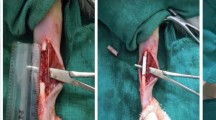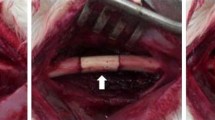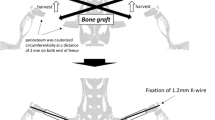Abstract
This study was designed to evaluate the effect of autologous bone marrow mesenchymal stem cells (MSCs) seeded into Gelfoam® on structural bone allograft healing. Thirty New Zealand white rabbits were divided into two groups. Segmental bone defect was created on diaphysis of the femur, and the defect was reconstructed with structural bone allograft. In experimental group, structural allograft was wrapped around by Gelfoam® containing autologous MSCs, whereas cells were not included in control group. At 4, 8, 12 weeks, the femur of rabbits underwent radiographic and histologic evaluation for bony union. Bone morphogenic protein-2 (BMP-2), BMP-4, BMP-7, vascular endothelial growth factor (VEGF), and receptor activator of nuclear factor-kappa B ligand (RANKL) were measured within the grafted periosteal tissue. Bony union was not achieved in both groups at 4 and 8 weeks. At 12 weeks, three out of five femurs in experimental group were united, but one out of five in control group was united. Mean Taira scores were significantly different between two groups. The expression of BMP-2 was significantly higher at 4, 8 weeks, the expressions of BMP-4 and BMP-7 were significantly higher at 8 and 12 weeks, and the expression of VEGF and RANKL were significantly higher at all time points in experimental group. Incorporation of the structural bone allograft could be enhanced if allograft is covered with Gelfoam® containing autologous MSCs. MSCs have influence on not only bone formation, but neo-angiogenesis, and bone resorption.









Similar content being viewed by others
References
Abada HT, Golzarian J (2007) Gelatine sponge particles: handling characteristics for endovascular use. Tech Vasc Interv Radiol 10(4):257–260
Abdallah BM, Kassem M (2008) Human mesenchymal stem cells: from basic biology to clinical applications. Gene Ther 15(2):109–116
Arinzeh TL, Peter SJ, Archambault MP, van den Bos C, Gordon S, Kraus K et al (2003) Allogeneic mesenchymal stem cells regenerate bone in a critical-sized canine segmental defect. J Bone Joint Surg Am 85-A(10):1927–1935
Ashton BA, Allen TD, Howlett CR, Eaglesom CC, Hattori A, Owen M (1980) Formation of bone and cartilage by marrow stromal cells in diffusion chambers in vivo. Clin Orthop Relat Res (151):294–307
Benevenia J, Zimmerman M, Keating J, Cyran F, Blacksin M, Parsons JR (2000) Mechanical environment affects allograft incorporation. J Biomed Mater Res 53(1):67–72
Camilli JA, Penteado CV (1994) Bone formation by vascularized periosteal and osteoperiosteal grafts. An experimental study in rats. Arch Orthop Trauma Surg 114(1):18–24
De Bari C, Dell’Accio F, Tylzanowski P, Luyten FP (2001) Multipotent mesenchymal stem cells from adult human synovial membrane. Arthritis Rheum 44(8):1928–1942
Eslaminejad MB, Mirzadeh H, Mohamadi Y, Nickmahzar A (2007) Bone differentiation of marrow-derived mesenchymal stem cells using beta-tricalcium phosphate-alginate-gelatin hybrid scaffolds. J Tissue Eng Regen Med 1(6):417–424
Eyre-Brook AL (1984) The periosteum: its function reassessed. Clin Orthop Relat Res (189):300–307
Garbuz DS, Masri BA, Czitrom AA (1998) Biology of allografting. Orthop Clin North Am 29(2):199–204
Guo MZ, Xia ZS, Lin LB (1991) The mechanical and biological properties of demineralised cortical bone allografts in animals. J Bone Joint Surg Br 73(5):791–794
Hayashi O, Katsube Y, Hirose M, Ohgushi H, Ito H (2008) Comparison of osteogenic ability of rat mesenchymal stem cells from bone marrow, periosteum, and adipose tissue. Calcif Tissue Int 82(3):238–247
Ito H, Koefoed M, Tiyapatanaputi P, Gromov K, Goater JJ, Carmouche J et al (2005) Remodeling of cortical bone allografts mediated by adherent rAAV-RANKL and VEGF gene therapy. Nat Med 11(3):291–297
Jones AL, Bucholz RW, Bosse MJ, Mirza SK, Lyon TR, Webb LX et al (2006) Recombinant human BMP-2 and allograft compared with autogenous bone graft for reconstruction of diaphyseal tibial fractures with cortical defects. A randomized, controlled trial. J Bone Joint Surg Am 88(7):1431–1441
Kadiyala S, Young RG, Thiede MA, Bruder SP (1997) Culture expanded canine mesenchymal stem cells possess osteochondrogenic potential in vivo and in vitro. Cell Transplant 6(2):125–134
Kagiwada H, Yashiki T, Ohshima A, Tadokoro M, Nagaya N, Ohgushi H (2008) Human mesenchymal stem cells as a stable source of VEGF-producing cells. J Tissue Eng Regen Med 2(4):184–189
Keramaris NC, Calori GM, Nikolaou VS, Schemitsch EH, Giannoudis PV (2008) Fracture vascularity and bone healing: a systematic review of the role of VEGF. Injury 39(Suppl 2):S45–S57
Koh JT, Zhao Z, Wang Z, Lewis IS, Krebsbach PH, Franceschi RT (2008) Combinatorial gene therapy with BMP2/7 enhances cranial bone regeneration. J Dent Res 87(9):845–849
Mankin HJ, Gebhardt MC, Jennings LC, Springfield DS, Tomford WW (1996) Long-term results of allograft replacement in the management of bone tumors. Clin Orthop Relat Res (324):86–97
Mardon HJ, Bee J, von der Mark K, Owen ME (1987) Development of osteogenic tissue in diffusion chambers from early precursor cells in bone marrow of adult rats. Cell Tissue Res 250(1):157–165
Nakahara H, Bruder SP, Goldberg VM, Caplan AI (1990) In vivo osteochondrogenic potential of cultured cells derived from the periosteum. Clin Orthop Relat Res (259):223–232
Nather A, Goh JC (2000) Biomechanical strength of large diaphyseal deep-frozen allografts. Cell Tissue Bank 1(3):201–206
Pereira RF, Halford KW, O’Hara MD, Leeper DB, Sokolov BP, Pollard MD et al (1995) Cultured adherent cells from marrow can serve as long-lasting precursor cells for bone, cartilage, and lung in irradiated mice. Proc Natl Acad Sci U S A 92(11):4857–4861
Pereira RC, Rydziel S, Canalis E (2000) Bone morphogenetic protein-4 regulates its own expression in cultured osteoblasts. J Cell Physiol 182(2):239–246
Ponticiello MS, Schinagl RM, Kadiyala S, Barry FP (2000) Gelatin-based resorbable sponge as a carrier matrix for human mesenchymal stem cells in cartilage regeneration therapy. J Biomed Mater Res 52(2):246–255
Prockop DJ (1997) Marrow stromal cells as stem cells for nonhematopoietic tissues. Science 276(5309):71–74
Rohanizadeh R, Swain MV, Mason RS (2008) Gelatin sponges (gelfoam) as a scaffold for osteoblasts. J Mater Sci Mater Med 19(3):1173–1182
Sakou T (1998) Bone morphogenetic proteins: from basic studies to clinical approaches. Bone 22(6):591–603
Salkeld SL, Patron LP, Barrack RL, Cook SD (2001) The effect of osteogenic protein-1 on the healing of segmental bone defects treated with autograft or allograft bone. J Bone Joint Surg Am 83-A(6):803–816
Taira H, Moreno J, Ripalda P, Forriol F (2004) Radiological and histological analysis of cortical allografts: an experimental study in sheep femora. Arch Orthop Trauma Surg 124(5):320–325
Tanaka T, Hirose M, Kotobuki N, Tadokoro M, Ohgushi H, Fukuchi T et al (2009) Bone augmentation by bone marrow mesenchymal stem cells cultured in three-dimensional biodegradable polymer scaffolds. J Biomed Mater Res A 91(2):428–435
Uchida A, Kikuchi T, Shimomura Y (1988) Osteogenic capacity of cultured human periosteal cells. Acta Orthop Scand 59(1):29–33
Udagawa N, Takahashi N, Jimi E, Matsuzaki K, Tsurukai T, Itoh K et al (1999) Osteoblasts/stromal cells stimulate osteoclast activation through expression of osteoclast differentiation factor/rankl but not macrophage colony-stimulating factor: receptor activator of nf-kappa B ligand. Bone 25(5):517–523
Younger EM, Chapman MW (1989) Morbidity at bone graft donor sites. J Orthop Trauma 3(3):192–195
Zhang X, Xie C, Lin AS, Ito H, Awad H, Lieberman JR et al (2005) Periosteal progenitor cell fate in segmental cortical bone graft transplantations: implications for functional tissue engineering. J Bone Miner Res 20(12):2124–2137
Zhang X, Awad HA, O’Keefe RJ, Guldberg RE, Schwarz EM (2008) A perspective: engineering periosteum for structural bone graft healing. Clin Orthop Relat Res 466(8):1777–1787
Zuk PA, Zhu M, Ashjian P, De Ugarte DA, Huang JI, Mizuno H et al (2002) Human adipose tissue is a source of multipotent stem cells. Mol Biol Cell 13(12):4279–4295
Acknowledgments
The authors wish to acknowledge the financial support of the Catholic Institute of Cell therapy Basic Science Programs Foundation.
Author information
Authors and Affiliations
Corresponding author
Rights and permissions
About this article
Cite this article
Lee, JY., Choi, MH., Shin, EY. et al. Autologous mesenchymal stem cells loaded in Gelfoam® for structural bone allograft healing in rabbits. Cell Tissue Bank 12, 299–309 (2011). https://doi.org/10.1007/s10561-010-9194-4
Received:
Accepted:
Published:
Issue Date:
DOI: https://doi.org/10.1007/s10561-010-9194-4




